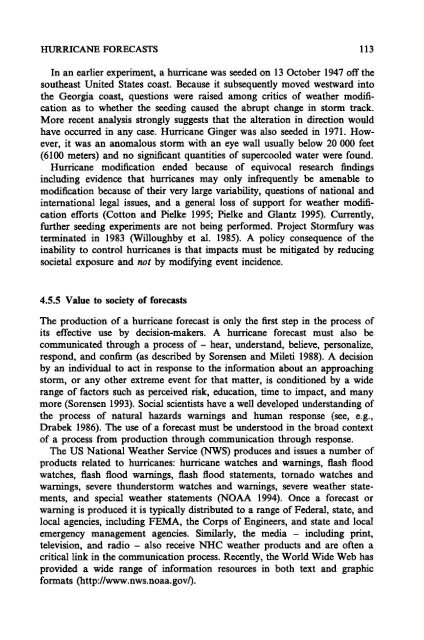Hurricanes: Their Nature and Impacts on Society - Climate Science ...
Hurricanes: Their Nature and Impacts on Society - Climate Science ...
Hurricanes: Their Nature and Impacts on Society - Climate Science ...
You also want an ePaper? Increase the reach of your titles
YUMPU automatically turns print PDFs into web optimized ePapers that Google loves.
HURRICANE FORECASTS 113<br />
In an earlier experiment, a hurricane was seeded <strong>on</strong> 13 October 1947 off the<br />
southeast United States coast. Because it subsequently moved westward into<br />
the Georgia coast, questi<strong>on</strong>s were raised am<strong>on</strong>g critics of weather modificati<strong>on</strong><br />
as to whether the seeding caused the abrupt change in storm track.<br />
More recent analysis str<strong>on</strong>gly suggests that the alterati<strong>on</strong> in directi<strong>on</strong> would<br />
have occurred in any case. Hurricane Ginger was also seeded in 1971. However,<br />
it was an anomalous storm with an eye wall usually below 20 000 feet<br />
(6100 meters) <str<strong>on</strong>g>and</str<strong>on</strong>g> no significant quantities of supercooled water were found.<br />
Hurricane modificati<strong>on</strong> ended because of equivocal research findings<br />
including evidence that hurricanes may <strong>on</strong>ly infrequently be amenable to<br />
modificati<strong>on</strong> because of their very large variability, questi<strong>on</strong>s of nati<strong>on</strong>al <str<strong>on</strong>g>and</str<strong>on</strong>g><br />
internati<strong>on</strong>al legal issues, <str<strong>on</strong>g>and</str<strong>on</strong>g> a general loss of support for weather modificati<strong>on</strong><br />
efforts (Cott<strong>on</strong> <str<strong>on</strong>g>and</str<strong>on</strong>g> Pielke 1995; Pielke <str<strong>on</strong>g>and</str<strong>on</strong>g> Glantz 1995). Currently,<br />
further seeding experiments are not being performed. Project Stormfury was<br />
terminated in 1983 (Willoughby et al. 1985). A policy c<strong>on</strong>sequence of the<br />
inability to c<strong>on</strong>trol hurricanes is that impacts must be mitigated by reducing<br />
societal exposure <str<strong>on</strong>g>and</str<strong>on</strong>g> not by modifying event incidence.<br />
4.5.5 VaIoe to society of forecasts<br />
The producti<strong>on</strong> of a hurricane forecast is <strong>on</strong>ly the first step in the process of<br />
its effective use by decisi<strong>on</strong>-makers. A hurricane forecast must also be<br />
communicated through a process of -hear, underst<str<strong>on</strong>g>and</str<strong>on</strong>g>, believe, pers<strong>on</strong>alize,<br />
resp<strong>on</strong>d, <str<strong>on</strong>g>and</str<strong>on</strong>g> c<strong>on</strong>firm (as described by Sorensen <str<strong>on</strong>g>and</str<strong>on</strong>g> Mileti 1988). A decisi<strong>on</strong><br />
by an individual to act in resp<strong>on</strong>se to the informati<strong>on</strong> about an approaching<br />
storm, or any other extreme event for that matter, is c<strong>on</strong>diti<strong>on</strong>ed by a wide<br />
range of factors such as perceived risk, educati<strong>on</strong>, time to impact, <str<strong>on</strong>g>and</str<strong>on</strong>g> many<br />
more (Sorensen 1993). Social scientists have a well developed underst<str<strong>on</strong>g>and</str<strong>on</strong>g>ing of<br />
the process of natural hazards warnings <str<strong>on</strong>g>and</str<strong>on</strong>g> human resp<strong>on</strong>se (see, e.g.,<br />
Drabek 1986). The use of a forecast must be understood in the broad c<strong>on</strong>text<br />
of a process from producti<strong>on</strong> through communicati<strong>on</strong> through resp<strong>on</strong>se.<br />
The US Nati<strong>on</strong>al Weather Service (NWS) produces <str<strong>on</strong>g>and</str<strong>on</strong>g> issues a number of<br />
products related to hurricanes: hurricane watches <str<strong>on</strong>g>and</str<strong>on</strong>g> warnings, flash flood<br />
watches, flash flood warnings, flash flood statements, tornado watches <str<strong>on</strong>g>and</str<strong>on</strong>g><br />
warnings, severe thunderstorm watches <str<strong>on</strong>g>and</str<strong>on</strong>g> warnings, severe weather statements,<br />
<str<strong>on</strong>g>and</str<strong>on</strong>g> special weather statements (NOAA 1994). Once a forecast or<br />
warning is produced it is typically distributed to a range of Federal, state, <str<strong>on</strong>g>and</str<strong>on</strong>g><br />
local agencies, including FEMA, the Corps of Engineers, <str<strong>on</strong>g>and</str<strong>on</strong>g> state <str<strong>on</strong>g>and</str<strong>on</strong>g> local<br />
emergency management agencies. Similarly, the media -including print,<br />
televisi<strong>on</strong>, <str<strong>on</strong>g>and</str<strong>on</strong>g> radio -also receive NHC weather products <str<strong>on</strong>g>and</str<strong>on</strong>g> are often a<br />
critical link in the communicati<strong>on</strong> process. Recently, the World Wide Web has<br />
provided a wide range of informati<strong>on</strong> resources in both text <str<strong>on</strong>g>and</str<strong>on</strong>g> graphic<br />
formats (http://www.nws.noaa.gov/).














